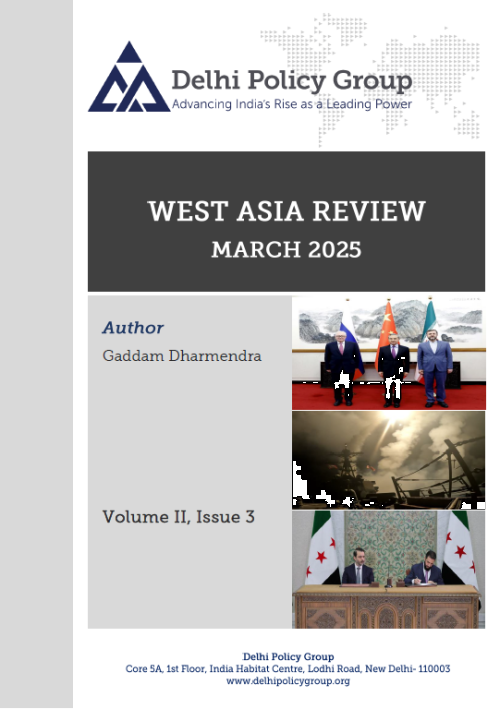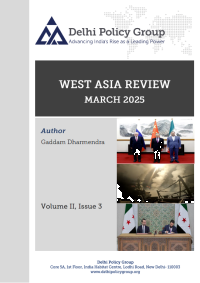West Asia Review
Date: April 09, 2025
An uneasy calm prevailed in parts of West Asia and the Levant, even as the US undertook a major military build-up in the region and launched a massive bombing campaign of Houthi positions in western Yemen.
This issue opens with an assessment of developments between the US and Iran, with communications being exchanged at the highest level expressing a desire to resume talks, but remaining deadlocked on process issues. The Annual Threat Assessment issued by the US DNI during the month suggested that Iran is not building a nuclear weapon, and that its Supreme Leader has not reauthorised the nuclear weapons programme he suspended in 2003. A meeting of the Deputy FMs of Iran, Russia and China, convened in Beijing, “welcomed Iran’s reiteration that its nuclear programme is exclusively for peaceful purposes, and not for the development of nuclear weapons”.
In their conversation on March 18, the Presidents of the US and Russia “spoke broadly about the Middle East as a region of potential cooperation to prevent future conflicts”, and “further discussed the need to stop the proliferation of strategic weapons.”
The author examines the collapse of the ceasefire in the Gaza Strip, leading to renewed military operations by the IDF.
Syria adopted a new Constitution, but the internal security situation in that country remains fragile, due mainly to rising sectarian violence against minorities, especially the Alawites. Syria’s interim government concluded an agreement with the US-backed (Kurdish) Syrian Democratic Forces, and was granted conditional waivers from extensive US sanctions.
India and Iran marked 75 years of the establishment of bilateral diplomatic relations.
These, as well as other regional developments, are covered in this March issue of the West Asia Review.
To read this West Asia Review, Vol. II, Issue 3, please see the PDF attached.
This issue opens with an assessment of developments between the US and Iran, with communications being exchanged at the highest level expressing a desire to resume talks, but remaining deadlocked on process issues. The Annual Threat Assessment issued by the US DNI during the month suggested that Iran is not building a nuclear weapon, and that its Supreme Leader has not reauthorised the nuclear weapons programme he suspended in 2003. A meeting of the Deputy FMs of Iran, Russia and China, convened in Beijing, “welcomed Iran’s reiteration that its nuclear programme is exclusively for peaceful purposes, and not for the development of nuclear weapons”.
In their conversation on March 18, the Presidents of the US and Russia “spoke broadly about the Middle East as a region of potential cooperation to prevent future conflicts”, and “further discussed the need to stop the proliferation of strategic weapons.”
The author examines the collapse of the ceasefire in the Gaza Strip, leading to renewed military operations by the IDF.
Syria adopted a new Constitution, but the internal security situation in that country remains fragile, due mainly to rising sectarian violence against minorities, especially the Alawites. Syria’s interim government concluded an agreement with the US-backed (Kurdish) Syrian Democratic Forces, and was granted conditional waivers from extensive US sanctions.
India and Iran marked 75 years of the establishment of bilateral diplomatic relations.
These, as well as other regional developments, are covered in this March issue of the West Asia Review.
To read this West Asia Review, Vol. II, Issue 3, please see the PDF attached.



